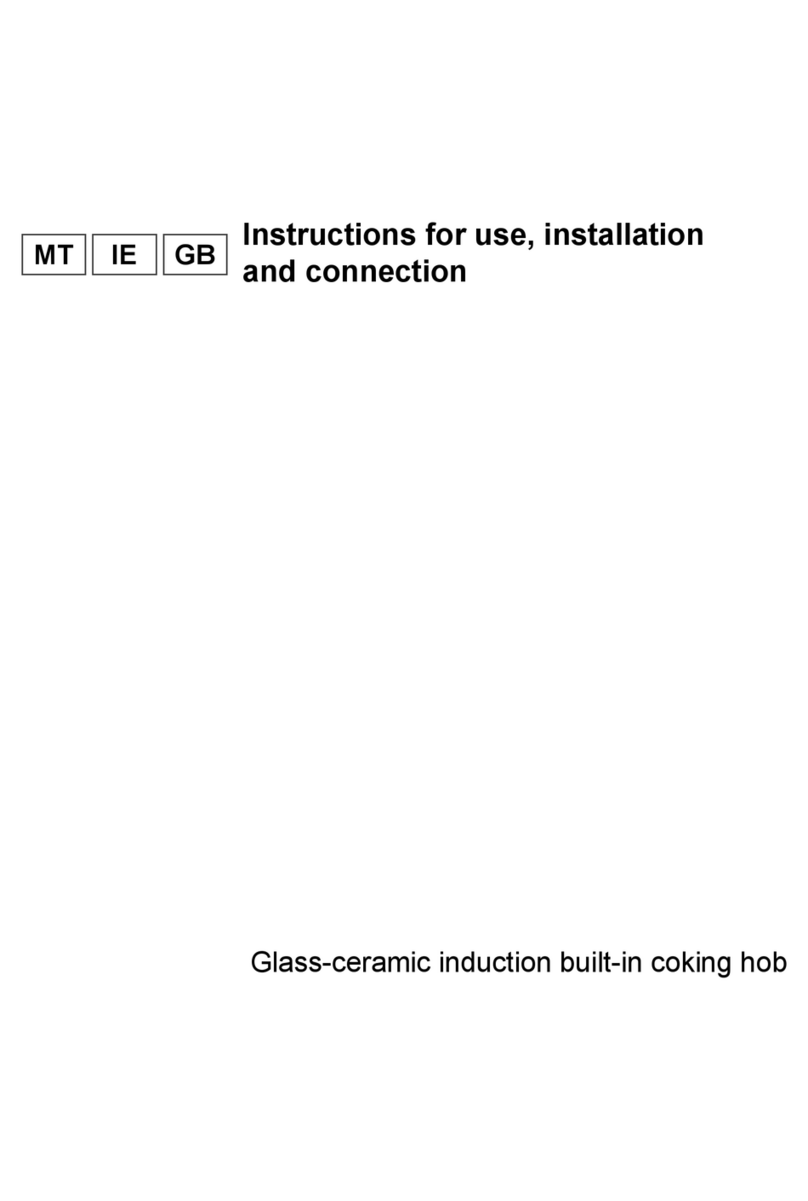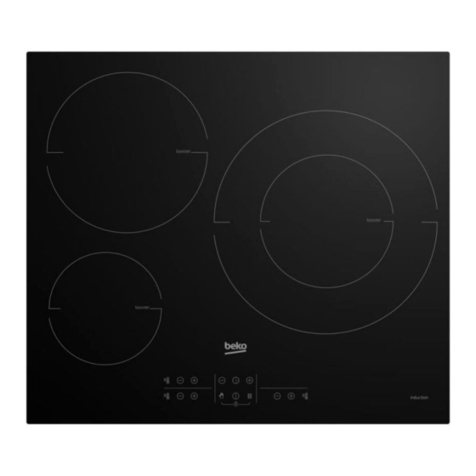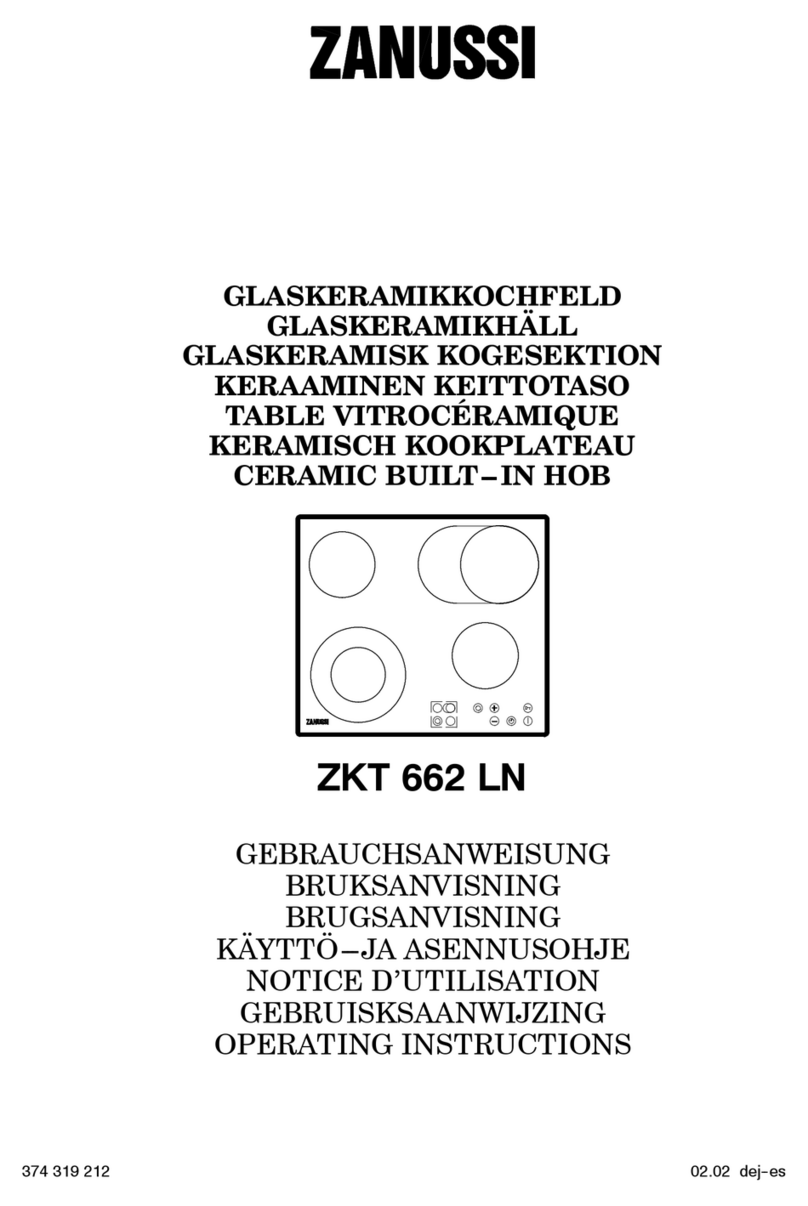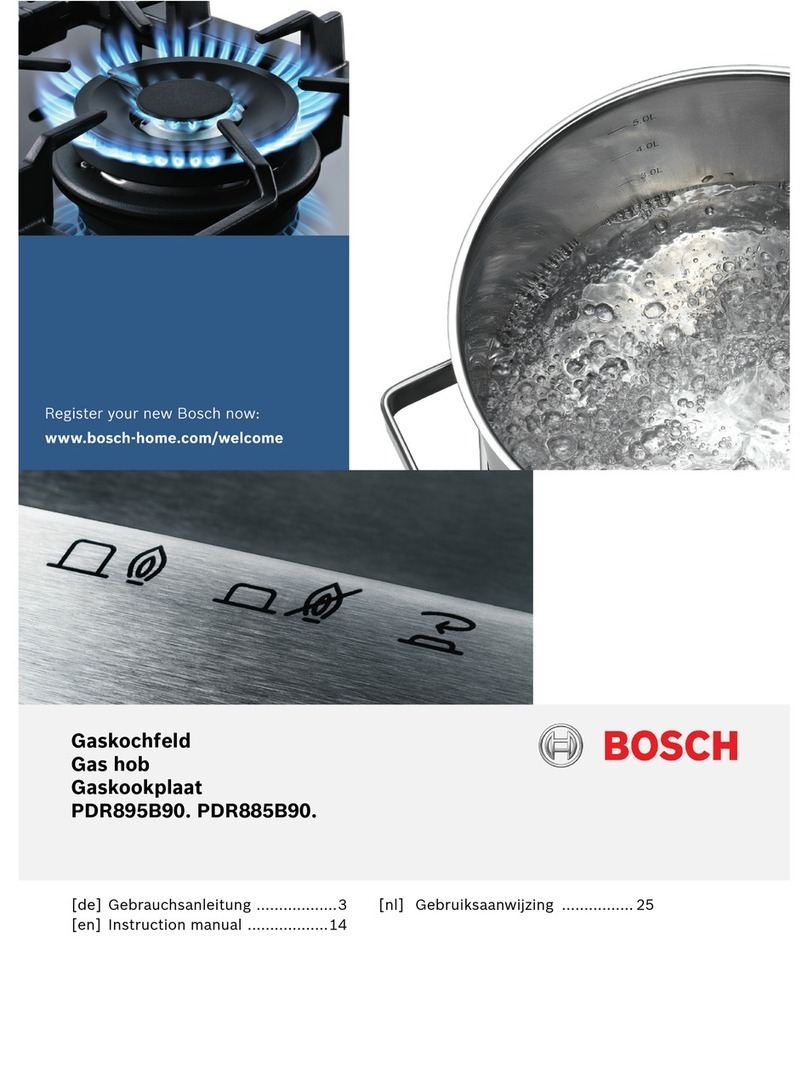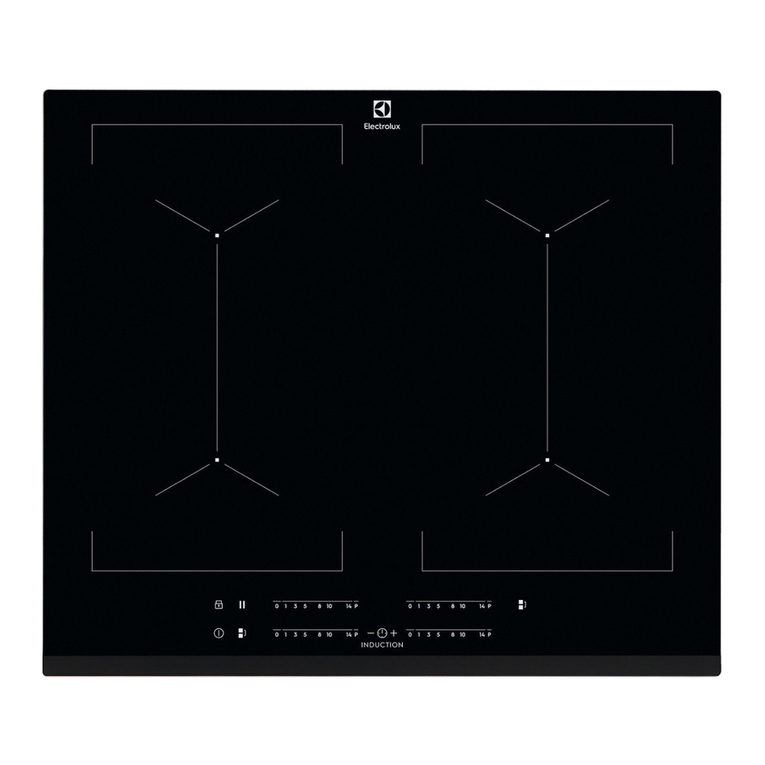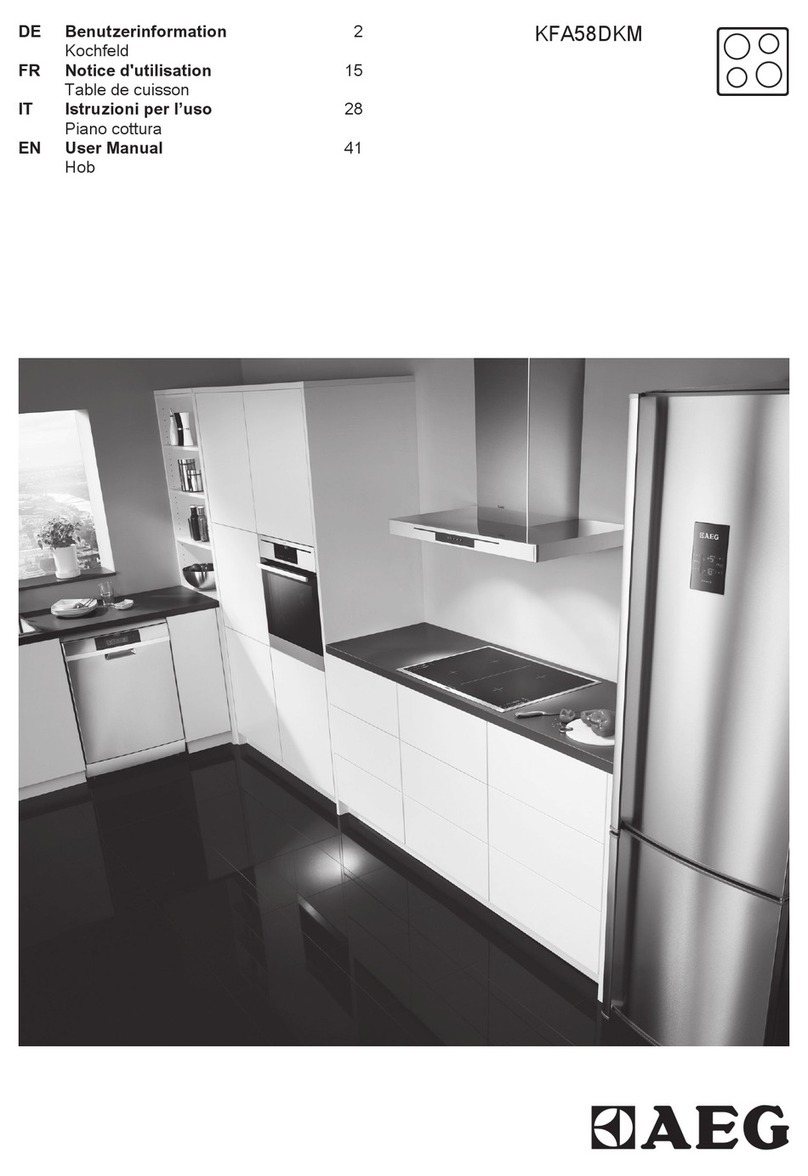EuropAce otimmo EIH 5220V User manual

BUILT-IN INDUCTION HOB
EIH 5220V
Thank you for purchasing EuropAce Products.
IN D U C T IO N IN D U C T IO N

Table of Contents
Pag e
1.IMPORTANT INFORMATION···································································3
2.BEFORE INSTALLATION·········································································5
3. INSTALLATION······················································································6
4.OTHER INSTALLATION REQUIREMENTS ···············································8
5.ELECTRICAL CONNECTION ··································································9
6.SAFETY PRECAUTIONS READ BEFORE OPERATING ····························10
7.THE PRINCIPLE INDUCTION·································································12
8.OPERATING THE TOUCH CONTROL·····················································13
9.POWER SHARING·················································································16
10.COOKWARE FOR YOUR INDUCTION··················································16
11.DO AND DO NOT················································································18
12.DAILY CARE OF YOUR APPLIANCE····················································20
13.USING AND MAINTAINING TIPS OF COOKING APPLIANCES WITH
TEMPERED TOUGHENED GLASS·························································21
To avoid the risk of accidents or damage to the appliance, it is essential
to read this instruction before it is installed or used for the first time.

3
1. IMPORTANT INFORMATION
This appliance can be used by children aged from 8 years and
above if theyhave been given supervision or instruction concerning
use of the appliance in a safe way and if theyunderstand the haz-
ards involved. Cleaning and user maintenance shall not be made by
children unless they are aged from 8 years andabove and super-
vised. Keep the appliance and its cord out of reach of children aged
less than8years.
Appliances can be used by persons with reduced physical, sensory
or mental capabilities or lack of experience and knowledge if they
have been given supervision or instruction concerning use of the
appliance inasafe way and if theyunderstand the hazards involved.
Children shall not play with the appliance.
If the supply cord is damaged, it must be replaced by the manufac-
turer, its service agent or similarly qualified persons in order to
avoidahazard.
Always disconnect the appliance from the supply if it is left unat-
tendedand before assembling, disassembling or cleaning.
This appliance shall not be used by children. Keep the
appliance and its cord out of reach of children.
WARNING: If the surface is cracked, switch off the appliance
to avoid the possibility of electric shock.
Steam cleaner shall not be used.
Metallicobjects such as knives, forks, spoons, and lids should
not be placed on the surface since they can get hot.
After use, switch off the hob element by its control and do not rely
on the pan detector.
Proper Installation - Be sure yourappliance is properly grounded
and installed by a qualified technician.
Never use the appliance for Warming or Heating the Room.
Do Not Leave Children Alone - Children should not be left alone or
unattended in an area where the appliance is in use. They should
never be allowed to sit or stand on any part of the appliance.

4
User Servicing
-
Do not repair or replace anypart of the appliance unless
specifically recommended in the manual. All other servicing should be
referred toaqualified technician
Storage in or on Appliance - Flammable materials should not be stored
near surface units.
Do Not Use Water on Grease Fires - Smother fire or flame or use dry
chemical or foam-type extinguisher.
Use Only Dry Potholders - Moist or damp potholders on hot surfaces may
result in burns from steam. Do not let potholder touch hotheating elements.
Do not use a towel or any bulky cloth.
Use Proper Pan Size - This appliance is equipped with several, differently
sized, induction elements. Select utensilshaving flat bottoms, large enough
to cover the cooking surface. The proper size of pots andpans will also
improve efficiency.
DO NOT TOUCH SURFACE UNITS OR AREAS NEARUNITS - Surface
units may be hot even though they are dark in color. Areasnear surface
units may become hot enough to cause burns, during and after use, do not
touch, or let clothing or other flammable materials contact surface units or
areasnear units until they have had sufficient time to cool.
Do Not Heat Unopened Food Containers – It willbuild-up of pressure and
may cause container to burst and result in injury.
Never Leave Surface Units Unattended at High Heat Settings-over-boil
causes smokes and greasy spillovers that may ignite.
Do not use aluminum foil, aluminum liners or aluminum containers on the
unit.
This appliance is not intended for use by persons (including children) with
reducing physical, Sensory or mental capabilities, or lack of experience and
knowledge unless they have been given supervision or instruction
concerning use of the appliance by a person responsible for their safety.
Children should be supervised to ensure that they do not play with the
appliances.
Utensil Handles Should Be Turned Inward and Not Extend over the
Adjacent Surface Units – To reduce the risk of burns, and spillage due to
unintentional contact with the utensil, the handle of a utensil should be
positioned so that it is turned inwards, anddoes not extend over adjacent
surface units.
Do not cook on broken cooktop - If cooktop should break, cleaning
solutionsand spillovers may penetrate the broken cooktop and create a risk
of electric shock, contact a qualified technician immediately.
Clean cool top with caution– If wet sponge or cloth is used to wipe spills on
ahot cooking area, be careful to avoid steam burn. Some cleaners can
produce noxious fumes if applied to a hot surface.

5
This manual is for the models as follows:
EIH 5220V
Dimension: 750x450mm
CAUTION
Do not store items of interest of children in cabinets above or around
the cooktop - children climbing on the cooktop to reach items, could
be seriously injured.
2.BEFORE INSTALLATION
If you are receiving the unit from a transportation company, it is the
customer's obligation to inspect the package and note any damage on
the delivery receipt. After delivery, have your induction cooktop carefully
unpacked, and again check for any visible damage. If you find any
damage to the unit at this point, immediately inform your dealer or
distributor. Although the responsibility for shipping lies with the carrier,
your dealer/distributor will assist you with your claim. If the unit is not
supposed to be installed for some time, you should keep it in its original
packaging, stored in a dry and safe place. Read through the section of
this manual which pertains to installation, and make sure that all of the
requirements can be provided or are already provided. Ensure that your
electric power supply is correct. Before you install the unit, you should
take a moment to write down the information from your nameplate and
fill-out the table on page 19, for future after-sale servicing needs. This
information will be required every time you call for any service on your
unit.

6
3. INSTALLATION
To install the cooktop, cut out a rectangular opening in the counter as
shown in the drawing and table below. Also ensure that you have a
minimum of 10mm (3/8”) of space in the front of the unit, between the rims
and front your counter for ventilation.
Apply the gasket only along the front rim and on both sides. Do not put this
gasket on the rim in the back. This gasket will prevent most of the spills from
entering the cabinetbelow andwill keep the unit in place. Once the gasket is
installed, place the cooktop in the opening, and lay it on the rim. Do this
carefully — do not drop the unit into the cutout. Make sure that the unit is
sitting properly on its rim all-round the perimeter.
Steps of Installation of the Hob:
1.Take out the screws which connect the installation board and Hob
and take away the installation board.
2.Fix the installation board to the installation desktop with the screws
provided in the packaging. As indicated below (graphics).
3.The power line must be lined to the adaptable electricity supply by
professionals.
4.Put the Hob in the sink carefully.
5.Fix the Hob to the installation sink with the screws originally used
for fixing the installation board.

7
EIH 5220V
Dimension:750x450mm

8
If your counter is produced from porous materials that tend to
swell if in contact with humidity and water, to better protect the
cutout, use proper sealants on the edge which would prevent any
penetration of humidity and water. Chamfer all exposed edges of
decorative laminates to prevent further chipping. Cutout radius
corners and file them to ensure smooth edges and prevent corner
cracking. Rough edges and inside corners that are not rounded
as well as forced fits can contribute to cracking of countertop
laminate.
4. OTHER INSTALLATION
REQUIREMENTS
During cooking, the built-in fan inside the
cooktop willoperate constantly to keep the
internal components cool. The air intake is
on the bottom of the cooktop box, and the
warm air exhaust is located on the back of
the rim, as shown on the obstructed, the
cooktop safeties will either diminish the
power output or shut down the unit. We
suggest that you should periodically check
that there is an object (dust, paper, etc.)
that could obstruct the air inlet under your
induction cooktop. Although induction
cooktop heat rejection is minimal and the
unit does not create any fumes in operation, such a unit must be
installed
.

9
Install underneath a properly sized ventilation hood for exhausting
any smell, vapor, and smoke created by cooking itself.
Also, a proper downdraft system can be used for ventilation. A
minimum vertical clearance of 750mm (30") is required between the top
of the cooking surface and the bottom of any unprotected combustible
material, such as cabinets, wooden trim, etc.
At the back, leave a minimum of 10mm (3/8")between the cooktop
edge and adjacent vertical surfaces (backsplash, wall, high cabinets,
etc.) This space is needed for the unit to breathe properly. If a
downdraft ventilation system is used a minimum 6mm (1/4") of
clearance is required between the rearedge of the cooktop and the
downdraft snorkel. Leaveaminimum of 50mm (2") underneath the unit
for air intake.
Your cooktop must always breathe adequately. Make sure that
the air inlet and its exhaust are not obstructed.
The unit must not be installed above a washing machine, a
refrigerator or a deep-freezer box.
To eliminate the risk of burns or fire by reaching over heated
surface units, cabinet storage space located above the surface
units should be avoided. The unit must be installed such that it
can be pulled without difficulty out of the cut-out for servicing
cleaning.
Never glue, silicone or wedge the unit inside its cut-out.
5. ELECTRICAL CONNECTION
Cooker top electrical characteristics are; Operating voltage 220-240V
50Hz Connect to 220-240V50Hz 16Amp for 2 zone hob and 32Amp
for 4 zone hob, minimum supply electrical wiring information. An
adequate electrical supply must be provided for this unit. All wire
connections and grounding must be done in accordance with local
electrical codes, of if these codes are not established, then with the
National Electrical Code.
This unit comes equipped with three connection wires inametal
150cm flexible conduit. The conduit must be routed and properly
connected to an approved owner-supplied electrical wall junction-box.

10
An approved connector must be used
for connecting the conduit to the
junction box, a three-wire, 2 poles,
220V50Hz service ("hot") wires, and
the green wire is to be connected to
the ground conductor.
The circuit protector for the unit should
be properly marked inside the electric
panel and anybody using the unit, or
technician servicing the unit, should be
advised of the circuit protector‘s
location, so that the power to the unit
can be disconnected whennecessary.
Once the unit is properly fitted and
connected to the electrical power supply, turn the unit on andensure
that all elements and controls are operating well. Note that yourunit is
designed for a stable and steady 220V supply and the manufacturer,
its distributors and dealer cannot be held responsible for any unit
malfunction due to inadequate electrical supply (inadequate cable size,
low voltage, power surge, etc.). Furthermore, if your residence has
only a 208V supply system, and if the voltage frequently fluctuates,
your cooktop may not function properly. It is recommended that the
connection to electrical supply is done by a qualified electrician. If there
is any visible physical damage on the conduit and the wires, the unit
must not be connected to the mains. A qualified electrician or
approved service agent should be called in to replace the wireand the
conduit. The exposed cable length is 1.5 meters.
6. SAFETY elements. READ BEFORE OPERATING
The COOKTOP
The induction-cooking unit has beendesigned for residential use and
food preparation,and all of the safety parameters have been rectified
accordingly. The unit incorporates numerous safety devices and
controls, and a few devices will be mentioned here. A number of
sensors monitor the temperature of internal components. If any of
these sensors sense that the temperature is above the limit, the power
output of the unit will automatically be reduced, allowing the
components to cool down.

11
Once this is achieved, the unit will continuetooperate normally at the
output level set initially by the operator.
Each induction coil is equipped withasensor that continuously
monitors the temperature of the bottom of the pan to prevent the pan
from overheating. Each induction soil is equipped withapan sensing
device. This device willnot allow the heating element to turn on unless
it senses cookware on the coil covering enough surface area. The
indication that the coil is not running is the flashing of the digital
display. Once the pan is put properly on the coil, the digital display will
become steady. Note that a small object such as a fork, a spoon, a
piece of jewellery, etc., will not be mistaken for a cooking utensil, and it
will not trigger this sensor. Moreover, this device will distinguish
between cookware that is or is not suitable for induction cooking. If a
cooking vessel that is not suitable for induction cooking is placed on a
coil there will be no power output on the coil.
If an operator leans on the keypad by chance for more than ten
seconds, controls will disable the heating section of the unit. This
occurrence is called 'long presses'and
appear on power displays. The unit will act the same if there is an
accumulation of some liquid on the keypad area, or if a damp cloth is
left sitting on the keypad. The section willbecome operational again
once the spill or the object/hand is removed,and the element turned
back on. In an effort of constantly improving our products, we reserve
the right to make any changes into internal components, as well as to
make any (cosmetic) modifications on the outside frame. This unit does
not contain any asbestos or asbestos-based components.
The users with heart pacemakers must consult with the pacemaker
manufacturer prior to using this cooktop which incorporates induction
heating source.
If a crackappears in the glass surface, disconnect the unit immediately to avoid any risk
of electric shock. If the unit is connected directly to supply insideajunction box, then
disconnect its breaker, or remove fuses manually.
Do not re-use your cooktop until the glass top is replaced.
When cooking never uses aluminum foil and never place products wrapped in aluminum foil,nor
products deep-frozen in aluminum packs on the hob. Aluminum foil could melt anddamage the
vitro-ceramic glass surface beyond repair.

12
7.THE PRINCIPLE OF INDUCTION
When an induction element, also called: ‘a heating zone', or simply:
coil'- is switchedon, the appropriate cookware is used, and the
desired level of heating power selected, the electronic circuit unit
('induction generator'or 'inverter')powers up the induction coil which
creates a magnetic field, This magnetic field continuously, and this
creates induced currents in the bottom of the utensil and ultimately
results in heat. The heat is transferred directly to the food being
cooked. Thus, induction heat makes the cookwareadirect source of
heat, featuringahigh level of efficiency with extremely low energy loss
andunparalleled heating level control. With induction cooking, there is
very little heating inertia. Induction cooking elements do not incorpo-
rate a heat generating element, unlike conventional electricrings,
halogen or radiant elements, etc., therefore heat levels can be
changed very quickly.
Energy efficiency for induction is within range of 90-95 %, compared
with 55-65% for conventional and radiant element, or 45%-55% for
gas-fueled burners, The energy efficiency contributes to substantial
energy saving, both beneficial to the owner as well as the environment,
Induction cooking elements are sensitive to the cookware type being
used:
If there is no cookware placed on the coil, or if the cookware is not of
induction grade, there will be no power emitted by the coil.
If the cookware is placed partially on the coil, or if it is smaller than
the coil, the internal sensors will reduce power to the coil that is the
principle of the induction.
If the cookware is fully removed from the coil, the power output will
be instantaneously reduced to '0'and, eventually, the controls will
turn the element off after a minute, unless the cookware is returned
back onto the coil.

13
When compared to the other methods of cooking, induction cooking
has a very slow level of ambient heat, thus makes cooking ventilation.
Finally, the vitro ceramic glass as a cooking surface barely becomes
hotand this makes cleaning much easier.
8. OPERATING THE TOUCH CONTROL
Graphics for control panel of double-radiant-zone (horizontal)
sensor touch temperature adjuster:
1. Switch button
2. Cooking mode selection
3. Display of cooking mode and power level indicator
4. Temperature up button
5. Temperature down button
6. Lock button
7. Timer
8. Display of cooking timer indicator

14
When compared to the other methods of cooking, induction cooking
has a very slow level of ambient heat, thus makes cooking ventilation.
Finally, the vitro ceramic glass as a cooking surface barely becomes
hotand this makes cleaning much easier.
8. OPERATING THE TOUCH CONTROL
Graphics for control panel of three induction-zone (vertical)
sensor touch temperature adjuster:
Graphics for control panel of four induction-zone (horizontal)
sensor touch temperature adjuster:
1. Switch button
2. Cooking mode selection
3. Display of cooking mode and power level indicator
4. Temperature up button
5. Temperature down button
6. Lock button
7. Timer
8. Display of cooking timer indicator

15
1. Power on and off the Hob
ON: Press the switch button gently until a "tick"is heard and the power indicator
the lamp is displayed.
OFF: Press the switch button gently until a "tick"is heard and the power indicator
lamp disappears.
NOTE: Proceed the next step within 10 seconds after turning on the hob, or the hob
will power off automatically.
2. Selecting cooking modes
After turning on the hob, press your finger on temperature adjustmentbuttons/
andadjust the temperature as needed. (1-9 level).
The button can be operated repeatedly. If you press your finger on the button, the
temperature will shift to the next level every 0.4 seconds. The "up"button can shift to
as high as level "9"and the "down"can shift to as low as level "1".
3. Overheating indicator
To ensure the safety of the hob,"E"is displayed on an electron tube and cooking is
halted automatically when the temperature of the controlling part is over 84 degrees
C. "E"will disappear and the hob will restart when the temperature of the controlling
part decreases to safety.
4. Locking the hob
To avoid misconduct, please use the locking function button when necessary.
LOCK: Press your finger on the lock button until a
"
tick
"
is heard and the indicator
lamp is displayed. Any operation on the function button willnot work until the hob is
unlocked.
UNLOCK: When the Hob is locked, you can remove the locking by pressing the lock
button until a "tick"is heard and the indicator lamp disappears.
5. Automatically power off the hob
If you forget to turn off one or more cooking modes after cooking, the sensor
touch switch will power off automatically. The sensor touch switch will
automatically power off after some hours according to different power levels.
The defaults are as follows:

16
T i p
For simultaneous use, favor the use of cooking zones located on opposite sides of the hob.
On the same side, the use of a cooking zone at maximum power results in an automatic
limitation of the other cooking zone on that side, which is indicated in the power level display.
T i p
To check the suitability of your cookware:
Place the vessel on a cooking zone at power level 4.
If the display remains on, your cookware is compatible.
If the display flashes, your cookware cannot be used with induction cooking.
You can also use a magnet to test the cookware.
If a magnet "sticks"to the bottom of the cookware, it is compatible with induction.
9. POWER SHARING
Under the presence thatonly one zone is used with an adequate cooking
vessel covering the whole surface of the coil,and that power on the zone is
adjusted to the maximum.
If only one coil is employed, it can be utilized at its maximum power, but as
soon as the other coil is turned on, the controls adjust the power on both
coilsautomatically for "power-sharing"
. This power-sharing is administered
by the unit‘s microprocessors, which will alternate power between the two
elements. There are two factors affecting improved power-sharing on your
cooktops.
The first is the application of improved technology for power sharing-not
using common relays, but rather semiconductors which makes power-
sharing quicker, thus more efficient. The second factor is that when in a
power-sharing mode, two zones can share the full power output of the
inverter.
Note that the controls will not allow both zones to operate at full power, and
the power will be adjusted automatically - e.g. the power on one zone is
adjusted toamaximum, and the other zone is turnedonandpower level
also adjusted to its maximum, the power level on the first zone will
automaticallybecome lower. This change will be visible on digital displays.
The controls are set in such a manner
that the last instruction (command) given to an element is always a priority.
10. COOKWARE FOR YOUR INDUCTION
Inducted current can be created only with materials thathave magnetic
properties. Thus cookware for use with an induction unit must be made from
a ferromagnetic material or have inserts with magnetic properties.

17
Yourhousehold may alreadyhave cookware suitable for induction cooking,
and you may test any utensil with an induction element. Incorporate controls
are able to recognizeasuitable cooking vessel.
Turn an element on andadjust power to any level, you will notice that the
digital power display is flashing. Fill your cooking vessel with some water
and place it on the coil. If the piece being tested is suitable for induction
cooking, the display will become steady. However, if it keeps flashing, the
cooking vessel cannot be used on your induction unit.
If the cooking vessel is empty, remove it from the coil immediately after
you have done the test and turn the element OFF.
Another simple test to determine if a piece of cookware can be used on an
induction cooktop is the magnet test. Use a magnetand place it on the
utensil. If the magnet sticks to it, the piece will work with induction.
COOKWARE COMPATIBLE WITH INDUCTION ARE:
1. Cookware made of enamel-coated steel with or without a non-stick
coating.
2. Cast iron cookware with or without enamel coated base.
3. Stainless steel pots and pans designed for induction cookware.
NOTE:
Stainless steel for cookware is non-magnetic, in most cases, and unsuitable
for induction cooking, but most manufacturers make such cooking vessel in
layers for better heat distribution, andagood number of such pots and pans
can be used with induction. To make sure if a stainless steel utensil can be
used,perform the utensil test.
The use of cookware with the enameled-coated base will prevent the glass
top of yourunit from getting scratched.
Pots andpans which do nothave a flat bottom still may be used,however,
they should not be overly deformed.
Cookware made from glass, ceramic, earthenware, aluminum, copper and
non-magnetic stainless steel cookware is not suitable for induction cooking.
MATCHING POTS & PANS WITH COIL, ETC.
Small elements, 16cm (6 1/2") are best utilized:
With small cooking vessel-but normally not smaller than 10cm (4
For slow cooking and simmering (sauces, creams, etc.)
For cooking small quantities of food.
Large elements, 22cm (9") are primarily designed for day-to-day cooking needs
and most commonly used pans-18 to 25cm (7 to 9/12

18
11. DO AND DO NOT
This appliance is not intended for use by persons (including children)
with reduced physical, sensory or mental capabilities, or lack of expe-
rience and knowledge unless theyhave been given supervision or
instruction concerning use of the appliance by a person responsible for
their safety.
Children should be supervised to ensure that they do not play with the
appliance.
If the supply cord is damaged, it must be replaced by the manufacturer,
its service agent or similarly qualified persons in order to avoid a
hazard.
Disposal of appliances and batteries.
After the implementation of the EuropeanDirective 2002/96/EU on the
national legal system, the following applies:
Electrical and electronic devices may not be disposed of with domestic
waste.
Consumers are obliged by law to return electrical and electronic devices
at the end of their service lives to the public collecting points set up for
this purpose or point of sale.
Details to this are defined by the national law of the respective
country. This symbol on the product, the instruction manual or
the package indicates that a product is subject to these regu-
lations. By recycling, reusing the materials or other forms of
utilizing old devices, you are making an important contribution
to protecting ourenvironment.
Cleaning and user maintenance shall not be made by children
without supervision
WARNING: The appliance and its accessible parts become hot
during use.
Care should be taken to avoid touching heating elements.
WARNING: Unattended cooking on a hob with fat or oil can be danger-
ousand may result in fire.
NEVER try to extinguish a fire with water, but switch off the appliance
and then cover flame e.g. withalid or a fire blanket.
WARNING: Danger of fire: do not store items on the cooking surfaces If
the hob surface is of glass-ceramic or similar material and protects live
parts, the instructions shall include the substance of the following:
WARNING: If the surface is cracked, switch off the appliance to avoid the
possibility of electric shock.
The appliance is not intended to be operated by means of an external
timer or separate remote-control system.

19
Always place your cookware such that its center is aligned with the center of the
coil.
Avoid hitting the vitro-ceramic glass with cookware of any hard objects-the glass
surface is highly resistant but not unbreakable.
Pick-up your cooking vessel when moving them around. Do not slide them and
avoid excessive rubbing of the top, as this leaves scratchesand erases the
markings.
Avoid using cookware with rough or deformed bottoms.
Avoid leaving any metal cooking accessories, knives and forks, or metal objects on
the hob. They may gethot if left close to any heating element in use.
Avoid storing flammable products in the cabinets under your cooktop.
Never leave an empty cooking vessel on an induction heating element, even
when the element is turned OFF.
Only use maximum power for boiling and frying.
Never try heating up a closed can.
Avoid pre-heating your non-stick pans (e.g. with Teflon coating) at maximum
heat.
Avoid storing solid and heavy items in the cabinets above your cooktop. They may
unintentionally drop and damage the glass.
ERROR CODE DISPLAY
Error Code Error description
E0 Line fault Thermostat short-cut due to high Temp.
U No pot
E2 IGBT temperature sensor opens
E3 High Voltage (>270V)
E4 Low Voltage (<140V)
E5 Open circuit of furnace temperature sensor
E6 Short circuit of furnace temperature sensor
FA Water overflow alarm
E8 IGBT temperature sensor short circuit
E9 IGBT over temperature
Do not connect any appliances to the plugs above or near to the induction
cooktop; connection cable insulation can melt if in contact with heat, and this
may result in an injury and property damage.
Your cooktop must never be used as a storage space or surface for piling up
of any material.

20
12. DAILY CARE OF YOUR APPLIANCE
MAINTAINING YOUR APPLIANCE
The cleaning of an induction cooktop is easy. Read and follow these recommendations:
TYPE OF STAINLESS STEEL POTS WHAT TO DO ACCESSORIES or AGENTS EMPLOYED
Minor Soak the area to be cleaned with soapy
water, then wipe it. Cleaning sponge & mild detergents
Accumulated burnt-on stains
Soak the area to be cleaned with warm
soapy water. Use a special scraper for
vitro-ceramic glass to remove grease and
food particles.Finish off with a cleaning
sponge then wipe it clean
Cleaning sponge. mold detergents and
cleanup agents for vitro-ceramic glass
Rings and traces of lime-scale
Apply warm white vinegar on the stain
Leave to act then wipe off with a soft cloth
OR Useacommercial cleaner on the
affected area. Note that such cleaner may
leave stains on a stainless steel frame,
thus protect to pose stainless steel.
Cleaning cloth, white vinegar, or
diluted de-liming agent.
Burnt-on stains following sugar spillage
melted aluminum or plastic
Apply special vitro-ceramic glass
cleaner on the surface, preferably the
one which contains silicone (Protective
action) Leave to act then finish off with
a cleaning sponge then wipe it clean.
vitro-ceramic tattoo cleaning agents and
sponge
Table of contents
Popular Hob manuals by other brands

VonReiter
VonReiter EKH6050-4ZB Instructions for use and installation

Candy
Candy PVI 630 Instructions for use and installation

ROSIERES
ROSIERES RID33 Instructions for use and installation
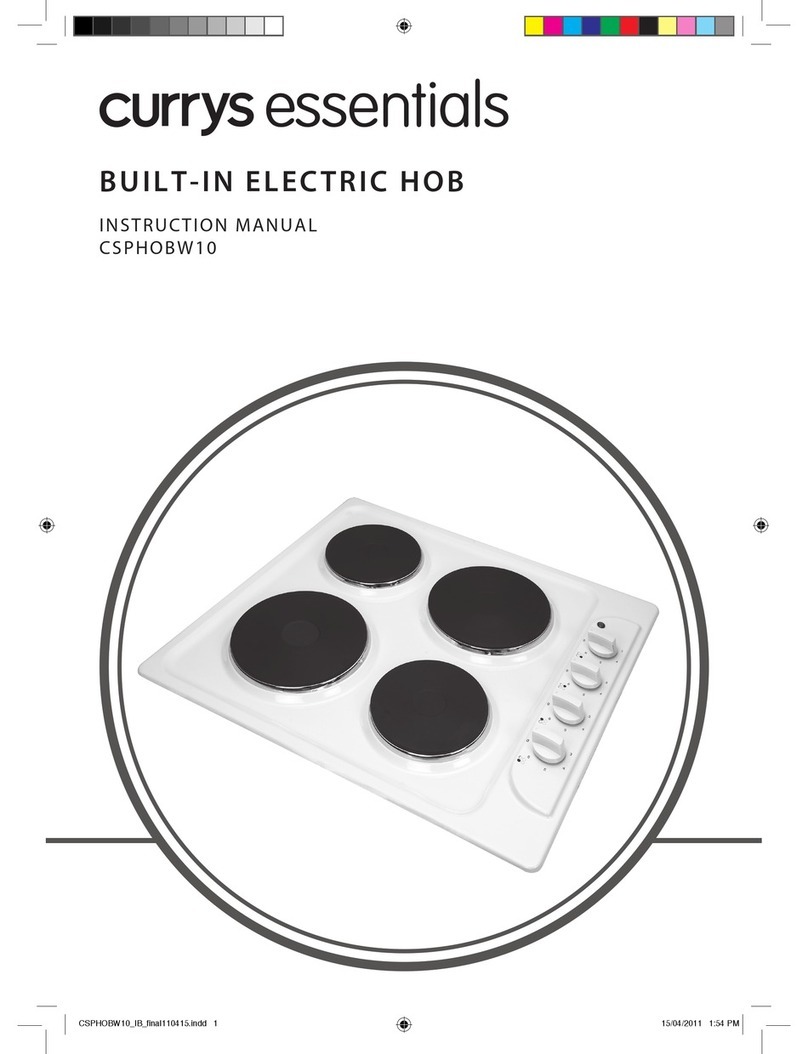
Currys Essentials
Currys Essentials CSPHOBW10 instruction manual
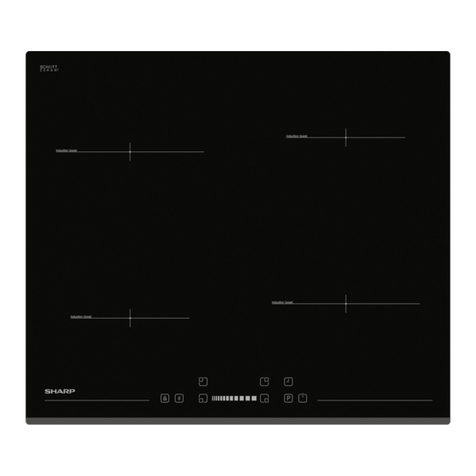
Sharp
Sharp KH-6I19BS00-EU user manual
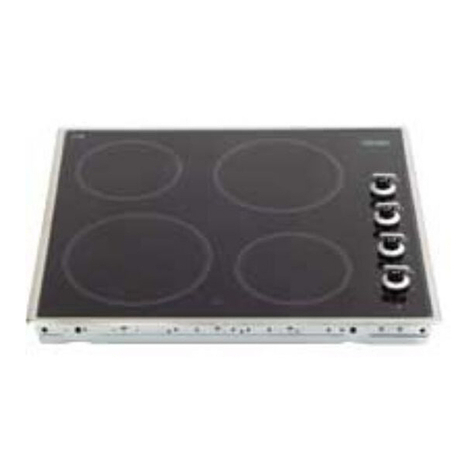
DeLonghi
DeLonghi CR 265 ST User operating instructions





